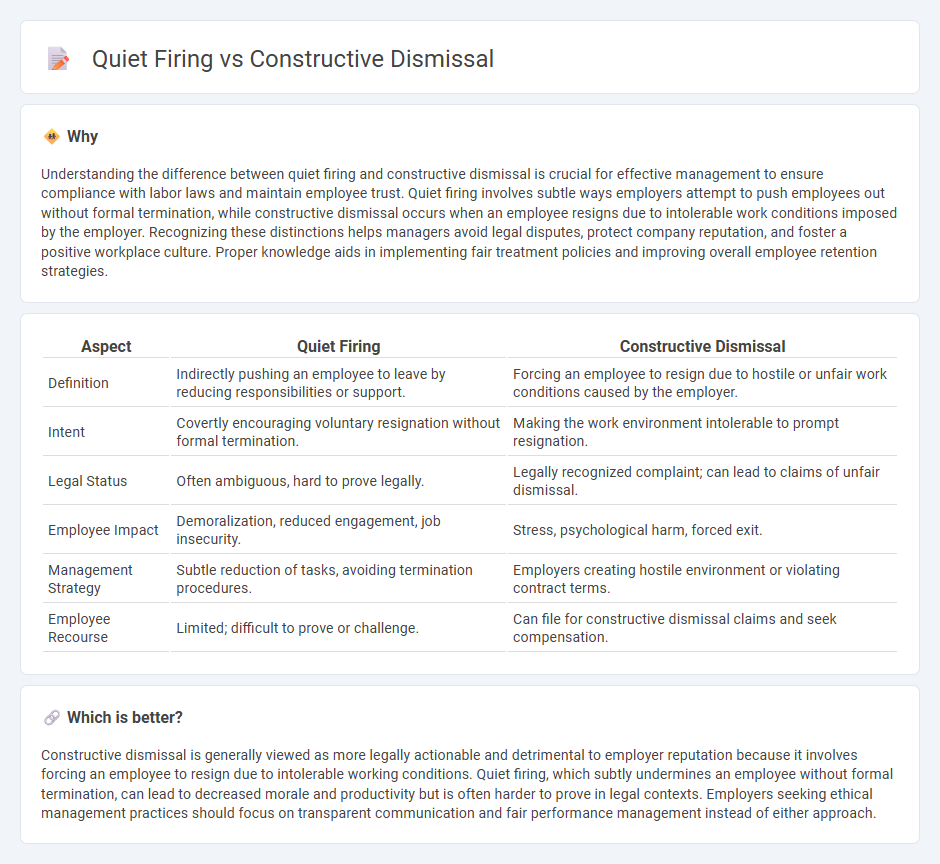
Quiet firing refers to subtle tactics used by employers to encourage an employee's voluntary resignation, often through reduced responsibilities or social exclusion, while constructive dismissal occurs when an employee is forced to resign due to a hostile or intolerable work environment created by the employer. Both concepts highlight critical challenges in workplace management and employee relations, impacting job security and organizational culture. Explore more to understand how to identify and address these complex workplace issues effectively.
Why it is important
Understanding the difference between quiet firing and constructive dismissal is crucial for effective management to ensure compliance with labor laws and maintain employee trust. Quiet firing involves subtle ways employers attempt to push employees out without formal termination, while constructive dismissal occurs when an employee resigns due to intolerable work conditions imposed by the employer. Recognizing these distinctions helps managers avoid legal disputes, protect company reputation, and foster a positive workplace culture. Proper knowledge aids in implementing fair treatment policies and improving overall employee retention strategies.
Comparison Table
| Aspect | Quiet Firing | Constructive Dismissal |
|---|---|---|
| Definition | Indirectly pushing an employee to leave by reducing responsibilities or support. | Forcing an employee to resign due to hostile or unfair work conditions caused by the employer. |
| Intent | Covertly encouraging voluntary resignation without formal termination. | Making the work environment intolerable to prompt resignation. |
| Legal Status | Often ambiguous, hard to prove legally. | Legally recognized complaint; can lead to claims of unfair dismissal. |
| Employee Impact | Demoralization, reduced engagement, job insecurity. | Stress, psychological harm, forced exit. |
| Management Strategy | Subtle reduction of tasks, avoiding termination procedures. | Employers creating hostile environment or violating contract terms. |
| Employee Recourse | Limited; difficult to prove or challenge. | Can file for constructive dismissal claims and seek compensation. |
Which is better?
Constructive dismissal is generally viewed as more legally actionable and detrimental to employer reputation because it involves forcing an employee to resign due to intolerable working conditions. Quiet firing, which subtly undermines an employee without formal termination, can lead to decreased morale and productivity but is often harder to prove in legal contexts. Employers seeking ethical management practices should focus on transparent communication and fair performance management instead of either approach.
Connection
Quiet firing and constructive dismissal both involve indirect methods employers use to push employees out without formal termination. Quiet firing occurs when management subtly undermines an employee's role through exclusion or reduced responsibilities, creating a hostile work environment that leads to constructive dismissal claims. Constructive dismissal arises when these adverse conditions effectively force the employee to resign, highlighting the legal and managerial implications of covert employee disengagement strategies.
Key Terms
Voluntariness
Constructive dismissal occurs when an employee resigns due to intolerable working conditions imposed by the employer, reflecting a lack of voluntariness in the resignation decision. In contrast, quiet firing involves subtle employer actions intended to encourage resignation without explicit dismissal, often undermining the employee's voluntary choice. Explore detailed insights on how voluntariness differentiates these practices and their legal implications.
Workplace Environment
Constructive dismissal occurs when an employer creates a hostile or intolerable workplace environment, forcing an employee to resign due to significant changes in job terms, demotion, or harassment. Quiet firing involves subtly diminishing an employee's responsibilities, excluding them from important projects, or making their work experience unpleasant without overt termination. Explore the key differences between these workplace practices to understand your rights and options.
Employer Intent
Constructive dismissal involves an employer deliberately creating a hostile work environment to force an employee's resignation, reflecting explicit intent to terminate. Quiet firing refers to an employer subtly sidelining or ignoring an employee to prompt voluntary departure without direct confrontation. Explore the legal distinctions and implications of employer intent in these scenarios for better workplace understanding.
Source and External Links
Constructive Dismissal Examples: A Guide for Employers - Constructive dismissal occurs when an employer commits a serious breach of contract that forces an employee to resign, such as a fundamental breach of express or implied employment terms; the employee must resign in response to this breach to prove constructive dismissal.
What Is Constructive Dismissal? - Constructive dismissal, also known as forced resignation, happens when an employer creates a hostile or intolerable work environment or makes severe changes to employment terms, compelling the employee to resign involuntarily, amounting to wrongful termination.
Constructive dismissal - In employment law, constructive dismissal is when an employee resigns due to intolerable working conditions created by the employer, effectively constituting dismissal and allowing the employee to claim legal remedies for wrongful termination.
 dowidth.com
dowidth.com